Stakeholder and social networks analysis of conservation partnership in Bantimurung Bulusaraung National Park, South Sulawesi, Indonesia
##plugins.themes.bootstrap3.article.main##
Abstract
Abstract. Sabar A, Maulany RI, Yusran, Kurniawan A, Rahmatullah RA, Syam MA, Syawal MA, Halis A, Rafiadi MT. 2023. Stakeholder and social networks analysis of conservation partnership in Bantimurung Bulusaraung National Park, South Sulawesi, Indonesia. Biodiversitas 24: 1017-1024. Social forestry or community-based forest management is increasingly promoted to increase the level of welfare of communities living around the forest, especially in many tropical countries, including Indonesia. One form of social forestry in Indonesia is Conservation Partnership (Kemitraan Konservasi) which is implemented in conservation areas and nature reserves. Since this scheme is relatively new, not extensive knowledge has been accumulated. This study aimed to identify the stakeholders involved in Conservation Partnerships in Bantimurung Bulusaraung National Park, focusing on the communities in Rompegading Village, Cenrana Sub-district, Maros District, South Sulawesi, Indonesia, and to analyze the pattern of social networks of each stakeholder in the management of the national park. Data were collected using observation, interviews, and literature research. We identify eight stakeholders involved in the Conservation Partnerships, namely Bantimurung Bulusaraung National Park, Sonrea Farmer Group, Rompegading Village Government, an NGO named Community Forest Service Team (TLKM), Center for Social Forestry and Environmental Partnerships (BPSKL Sulawesi), Bulusaraung Forest Management Unit (FMU), Faculty of Forestry Hasanuddin University, and a private company named PT. Adimitra. Each stakeholder involved in the Conservation Partnerships has different interests, goals, power, and legitimacy. The three stakeholders with the most significant interest, power, and legitimacy are Bantimurung Bulusaraung National Park, BPSKL Sulawesi, and TLKM. The results of the social network analysis indicate that the interaction among stakeholders is incomplete since not all stakeholders interact with each other. Thus, this study recommends the stakeholders to facilitate training on forest management and institutional strengthening, and also conduct stakeholder meetings to comprehend institutional roles in conservation partnerships as well as a medium for equal information exchange.
##plugins.themes.bootstrap3.article.details##
Most read articles by the same author(s)
- Y. YUSRAN, E. ERNIWATI, D. WAHYUNI, R. RAMADHANIL, A. KHUMAIDI, Diversity of macro fungus across three altitudinal ranges in Lore Lindu National Park, Central Sulawesi, Indonesia and their utilization by local residents , Biodiversitas Journal of Biological Diversity: Vol. 22 No. 1 (2021)
- WARDIMAN MAS'UD, RISMA ILLA MAULANY, PUTU SUPADMA PUTRA, PUTU OKA NGAKAN, Impacts of edge effects on the invasion of alien plant species in Bantimurung Bulusaraung National Park, Indonesia , Biodiversitas Journal of Biological Diversity: Vol. 24 No. 11 (2023)
- TAUFIQ ISMAIL, RISMA ILLA MAULANY, PUTU OKA NGAKAN, Abundance assessment of Sulawesi Banded Swallowtail, Papilio gigon gigon and availability of resource plants in Bantimurung Bulusaraung National Park, South Sulawesi, Indonesia , Biodiversitas Journal of Biological Diversity: Vol. 25 No. 2 (2024)
- IIN PERTIWI A. HUSAINI, RISMA ILLA MAULANY, NASRI NASRI, PUTU OKA NGAKAN, Diversity and use of traditional medicinal plant species in Bantimurung-Bulusaraung National Park, Indonesia , Biodiversitas Journal of Biological Diversity: Vol. 23 No. 11 (2022)
- YUSRAN YUSRAN, Isolation and screening of Pseudomonas fluorescens isolates against Fusarium oxysporum f. sp. radicis-lycopersici and their effects on seedling growth of Paraserianthes falcataria , Biodiversitas Journal of Biological Diversity: Vol. 24 No. 4 (2023)

